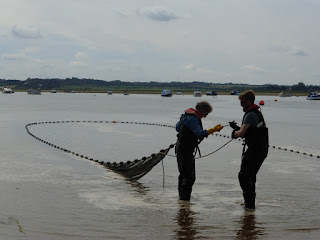Hauling in the Seine net in the harbour
Dr. Martin Perrow and Joe Cockram
Hauling in the net in Pinchen's Creek
With a warm night and good cloud cover on 27th June we decided to run another moth trap. We were rewarded with our best catch so far this season. Here are the stars of the show:
Archer's Dart
Bright-line Brown-eye
Dark Arches
Elephant Hawkmoth
Lychnis
Smoky Wainscot
Tawny Shears
In other news, we have seen the first fledged Common Tern on the West Sands and the first Little Tern chick on Far Point. Migration, as usual at this time of year, has been quiet with only a Spotted Flycatcher seen in the Plantation and a slow trickle of hirundines and swifts flying west.
First Little Tern chick of 2015 (photographed under license)
- Paul and Sarah

















































